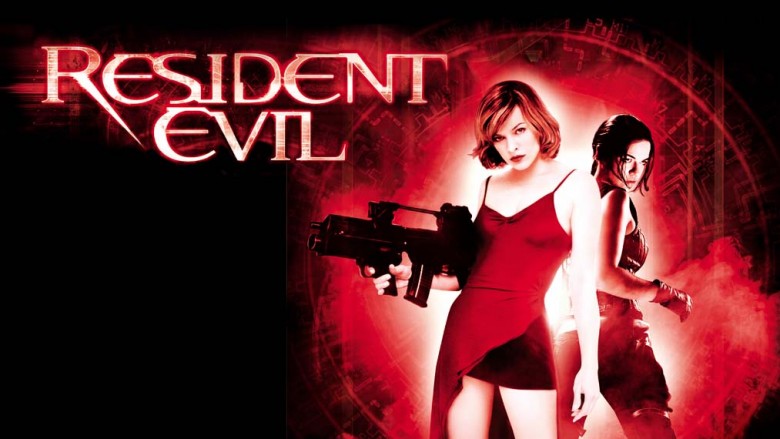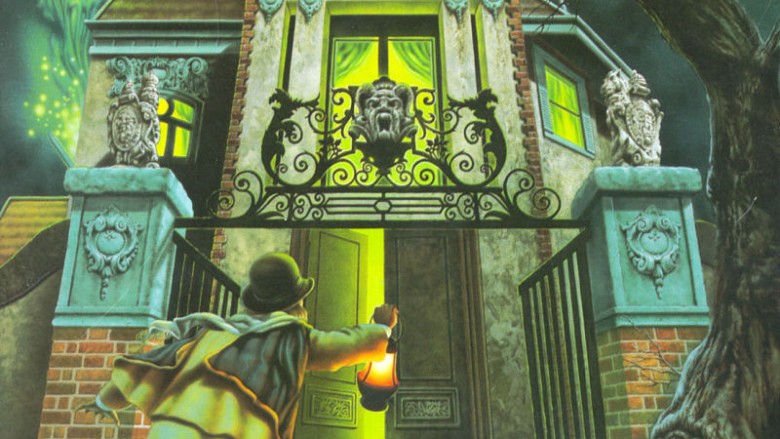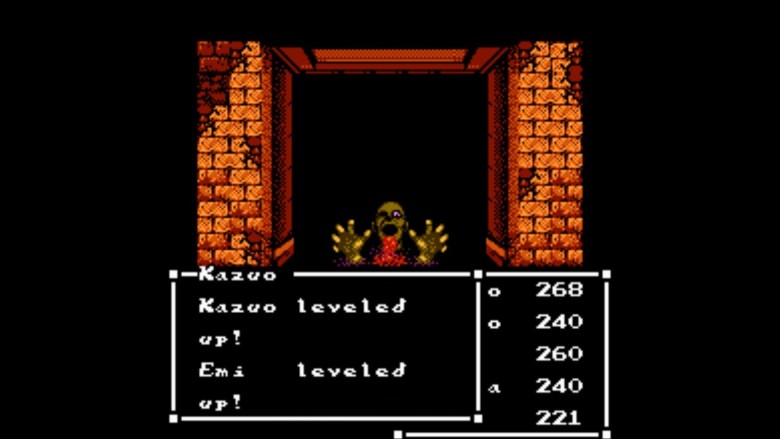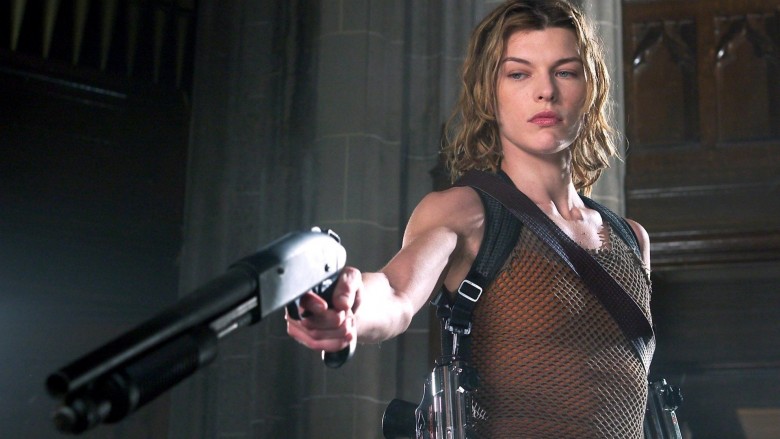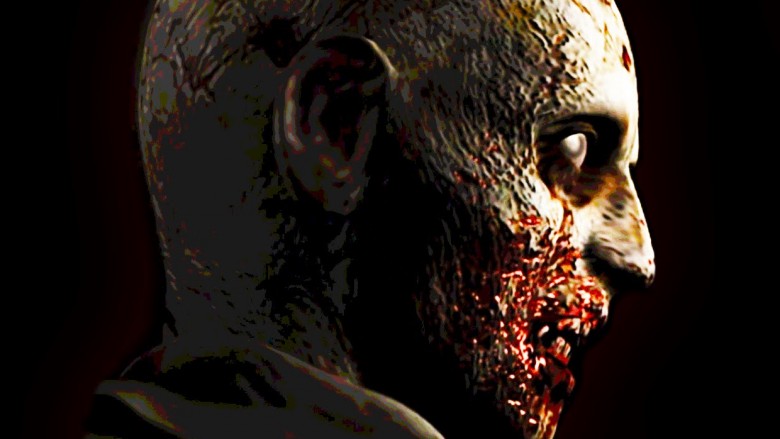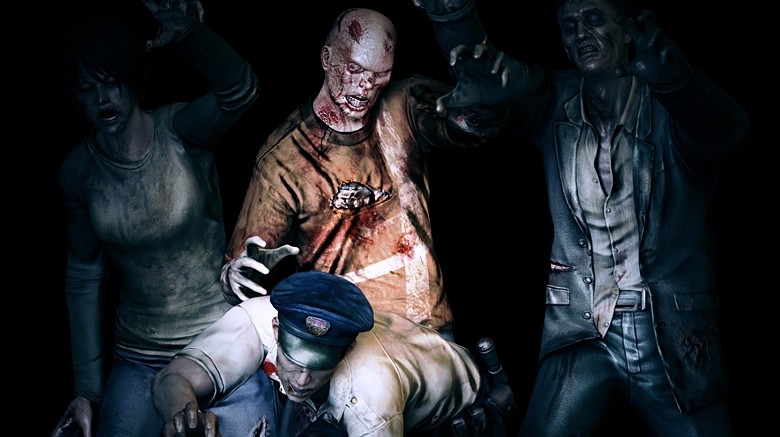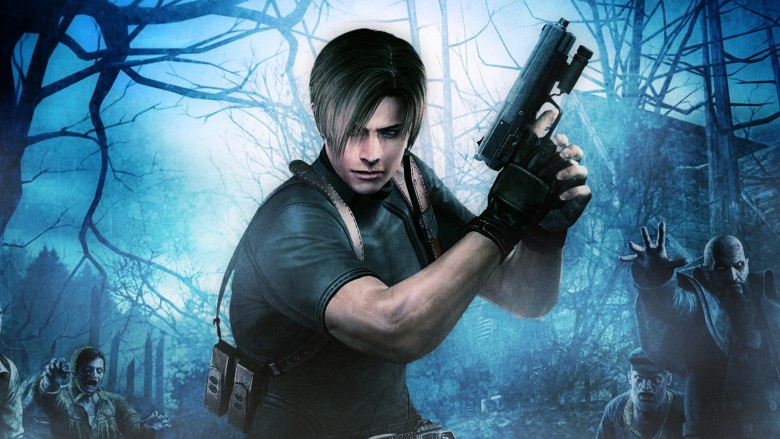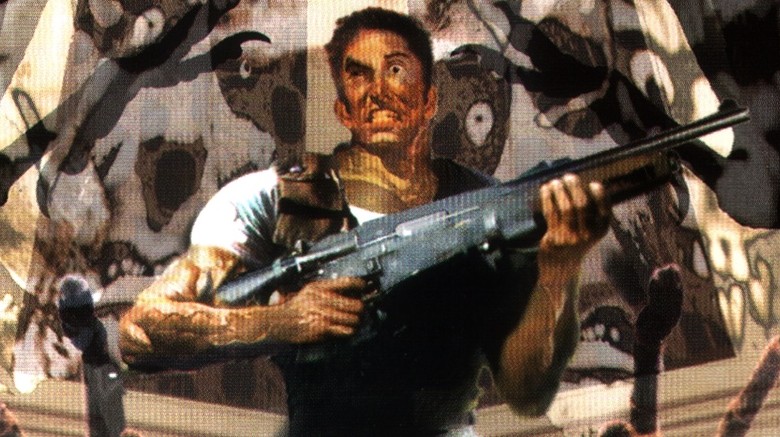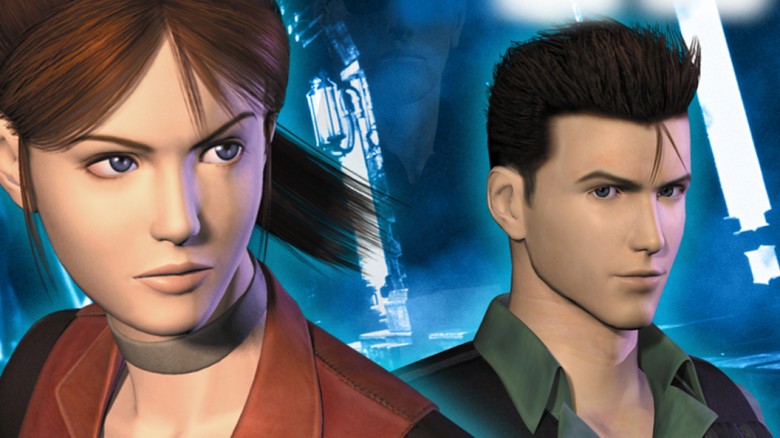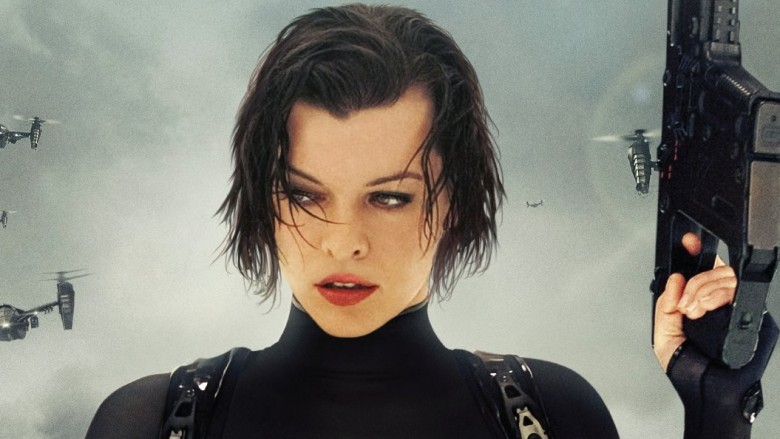False Facts About Resident Evil You Always Thought Were True
The Resident Evil series has become as much of an unstoppable force as the zombies that their protagonists must fight. From its humble beginnings as a game set in a spooky mansion to movies starring Milla Jovovich fighting for the fate of the world, this series has been a hell of a ride for game and movie audiences alike.
It's easy for fans to assume that they've uncovered every weird secret, but there are always new things to discover about Resident Evil—and there might even be some things you believe about the franchise that turned out to be completely false. To unlock these secrets, you don't need to be a "master of lockpicking" like Jill Valentine; you just have to keep reading.
The first movie was never meant to be like the games
For fans of the original Resident Evil games, the first movie was something of a shock. Many aspects of the original story were present, such as the shady Umbrella Corporation, a creepy mansion, and a small army of the undead. However, those expecting to see the adventures of game protagonists Chris Redfield and Jill Valentine were surprised to encounter original characters like Alice and Matt Addison. Thy ended up encountering some original enemies, too, such as the spooky Red Queen. However, the movie was still a hit, and the studio literally built a franchise on Milla Jovovich's ass-kicking Alice. You might assume that telling a completely original story and using original characters was always part of the plan, but nothing could be further from the truth.
Obviously, Resident Evil as a franchise owes a lot to zombie auteur George Romero. And after he produced a high-quality television ad for Resident Evil 2 for Japanese audiences, Sony hired him to both write and direct the first Resident Evil movie. Romero promptly produced a script with all of the familiar elements, including characters Chris Redfield and Jill Valentine. In fact, he was so true to the game that the script even included some of the weirder monsters, such as giant carnivorous plants and mutated sharks. Surprisingly—and for reasons that have never really been made clear—the studio ended up passing on Romero's treatment.
It's the first survival horror game
Over the years, the Resident Evil games have become synonymous with the the term "survival horror." That's not surprising, considering Capcom invented that particular term. As a description for a type of video game, it's pretty useful, as Resident Evil helped to define the genre in which players focus primarily on simply keeping their character alive during a series of horrific events. They did not, however, invent it.
Some people point to 1982's 3D Monster Maze as the first in the genre. Aside from having a title that could serve as a surprisingly on the nose description of the later Resident Evil games, 3D Monster Maze finds your character navigating a maze and trying to avoid being eaten by a T-rex. Another, more direct predecessor would be 1992's Alone in the Dark, in which a character tries to survive a spooky mansion while walking around in pre-rendered backgrounds. Hell, this game is so much of a Resident Evil prototype that you choose between a male and female character and fight zombies (although there are many other baddies as well). There's one more game that had a huge influence on Resident Evil, and it's called Sweet Home.
It's an original idea
Many people believe Resident Evil is a relatively original idea. Sure, people can quibble about many of the different elements being "borrowed" from other sources, from the Romero-esque zombies to the weird translations that ended up being an unintended homage to bad, B-movie dialogue. Resident Evil gets props for synthesizing everything into a unique package no one had really seen before—except they had, on the Nintendo.
It started with a strange game called Sweet Home, released on the Famicom (the Japanese version of the original Nintendo Entertainment System) and adapted, with many liberties, from a Japanese horror movie of the same name. The game involves five characters exploring a spooky mansion, and includes a number of surprisingly familiar aspects, including the anxiety-inducing animation every time you open a door. The mansion is full of weird puzzles to solve in order to open hidden areas and progress, and there are even quick-time events that serve as inspiration for later Resident Evil games. Certain characters have unique items (just like RE's Jill and Chris would later), and characters struggle with a limited inventory system.
The mystery of the mansion and the story are unfolded by exploration, and while the primary bad guys were spirits and other ghouls rather than shambling zombies, this game served as the clear DNA for Resident Evil. No wonder: Resident Evil was originally conceived as a Sweet Home remake before its creators decided to do something new.
That the movies were inspired mostly by horror movies
Considering that the video game source material is directly inspired by films such as Dawn of the Dead and Night of the Living Dead, many fans assume the movies also have their roots in horror. But there's more to the story, starting in the very first film: while there are the predictable legions of shambling zombies, there's also an evil Artificial Intelligence system and hallways filled with deadly lasers. How did those end up in there? Turns out the director wasn't really inspired by horror at all.
In an interview, director Paul W.S. Anderson revealed, "We've never seen them as zombie movies as much as science fiction thrillers." In fact, he identifies this "sci-fi thriller edge" to his movies as one of the reasons they've found such success outside of North America; as he says, "home invasion movies," which zombie films are an extension of, don't really "resonate" because many Europeans don't worry about it.
It was always about zombies
At this point, the Resident Evil games have settled in with zombies as the main antagonists. And while later games have explored different kinds of infected humans (mostly in an excuse to have faster, more action-oriented zombies), the series always manages to come back to its roots. Because of this, it's natural for casual fans to assume the series was always meant to be about zombies—but they actually came pretty close to busting ghosts instead.
Since the first Resident Evil was nearly a remake of Sweet Home, it makes sense that the creators considered using ghosts instead. Series creator Shinji Mikami revealed that he's always been more scared of ghosts than anything else, so at first, he imagined they'd make for a good, spooky antagonist. However, he quickly realized that the somewhat intangible nature of ghosts means that players would not ever feel any "exhilaration" while attacking spirits. He wanted something more solid, and drew immediate inspiration from the original Dawn of the Dead. To hear him tell the story, this was the major "ah-ha" moment for the entire franchise, as he realized his game could let players do what the doomed characters in the movies never could: "survive the experience."
The characters should know what zombies are
Audiences that watch the first Resident Evil movie are often surprised at the lack of pop culture awareness exhibited by the characters. We see them struggle to figure out what's happening and what they're facing, and we want to scream "Haven't you ever watched a zombie movie before?" Well...maybe they haven't.
How can you tell? The most basic evidence is that the word "zombie" is never used in the movie to describe what are clearly zombies. Some speculate that Resident Evil—and similarly non-"zombie" media like The Walking Dead—take place in a universe where there are no zombie movies, TV shows, games, and so on. Perhaps the reason characters in a Dawn of the Dead homage don't verbally recognize zombies is simply that they inhabit a universe where Dawn of the Dead was never released?
Leon was always the star of Resident Evil 4
Resident Evil 4 was undoubtedly a revolutionary game, both in terms of the series and for the industry in general. It featured enemies infected with a different kind of virus, so your foes were fast, used weapons (from pitchforks to chainsaws), and were generally terrifying. The game also switched to a more organic "over-the-shoulder" control scheme that replaced the classic Resident Evil use of weird camera angles and tank-style controls. For all of this change, though, there was familiarity in the character of Leon Kennedy. While he's certainly moved up in rank (the former Raccoon City police officer is now trying to rescue the president's daughter), the familiar presence of the Resident Evil 2 character helped the game feel grounded in franchise mythology. It's understandable, then, that most fans would think his presence was planned from the beginning. However, he wasn't always going to be the star of the game...in fact, it was almost Dante from Devil May Cry.
The Resident Evil series had been wildly successful, but it was starting to get predictable. Each game featured a relatively weak protagonist scrounging together weapons and mostly trying to survive. So the earliest iterations of Resident Evil 4 featured more action, fast enemies, and a more supernatural character that liked to use swords. Eventually, Capcom realized they'd departed too much from the formula, but not before discovering some funny bugs in the game, such as the power to "juggle" enemies in the air with repeated strikes. Capcom, sensing that there might be a new success in their failure to reinvent Resident Evil, used what they had to create Devil May Cry, right down to that juggling ability. Meanwhile, Resident Evil 4 retained some of the emphasis on action, but was much more down-to-earth in its focus on a vulnerable human protagonist who relies on guns and grenades rather than swords.
The games were always meant to be third-person
Capcom made more than a few waves when they announced Resident Evil 7 would be entirely first-person. There were certainly some compelling reasons to do it, ranging from the generally improved sense of immersion to the fact that this made converting the game to Playstation VR much easier. Some fans were wary after earlier attempts at doing Resident Evil in first-person, such as the generally reviled Resident Evil Survivor games, but what many never realized is that the franchise's standard perspective was originally supposed to be different.
When the first Resident Evil was just a twinkle in Shinji Mikami's eye, he and the rest of the team considered making it a first-person shooter in the flavor of a more horror-themed Doom, and early artwork reveals that one of the protagonists was going to be a cyborg. It didn't take long for Mikami and the team to latch on to Alone in the Dark and make their story more grounded (as much as a story about killer zombies can ever be), but if things had turned out just a little differently, Resident Evil could have been a series of games about cyborgs running and gunning their way through mobs of the undead.
Resident Evil: Code Veronica was always meant as a spinoff
For casual gamers, one of the most confusing elements of the Resident Evil series has less to do with its convoluted plots and baffling dialogue than its numbering system. Recently, Capcom released Resident Evil 7, but there have been many more games in the series. And while it makes sense not to give a coveted number title to weird spinoffs such as the aforementioned Resident Evil Survivor, there are also games with a huge connection to the story that are technically listed as spinoffs. Chief among them is Resident Evil: Code Veronica, which had the interesting distinction of debuting on Sega's Dreamcast rather than a Sony system.
Originally, Resident Evil: Code Veronica was meant to be Resident Evil 3, as it continued the stories, characters, and mythologies established in previous games. Meanwhile, the title that ultimately ended up being Resident Evil 3 was originally meant to be the spinoff. In retrospect, this makes a lot more sense; RE3 functions as a kind of side story detailing what Jill Valentine was doing during the events of Resident Evil 2. So, what happened to prompt the switch? The short answer is "Sony." Specifically, Capcom had an exclusivity contract with Sony that obliged them to release a main, "numbered" Resident Evil title on a Sony system. The game that became Resident Evil 3 fulfilled that while allowing the team to work on the more ambitious story of Code Veronica and design it for the beefier hardware of the Sega Dreamcast.
The movies are exploiting Milla Jovovich
While having her portray unique character Alice instead of a video game mainstay like Jill Valentine seemed surprising when the first Resident Evil movie came out, Milla Jovovich quickly established herself as a bona fide action badass capable of shouldering an entire franchise. Some critics, however, would be forgiven for thinking the movies are a bit exploitative of the beautiful Jovovich. During Resident Evil: Retribution, for example, she's running around in skintight black leather. Throw in the fact that she's married to series director Paul W.S. Anderson, and the whole thing takes on the air of highly public fetish.
Here's the thing, though: Anderson isn't the reason Jovovich is running around in skimpy outfits. In fact, she's stated that she played a part in designing her Retribution outfit, arguing it's "the epitome of Alice." With this simple confession, Jovovich underscored her passion for her character and the fact that she's far from shy about showing off her body—which makes sense. There's no room for modesty during the apocalypse, after all.


